Electromagnetic Micromotors—Design, Fabrication and Applications
Abstract
:1. Introduction
2. Electromagnetic Actuation Principles
 is given as [15]:
is given as [15]:

 the volume current density,
the volume current density,  the magnetic flux density, and
the magnetic flux density, and  the magnetic field intensity. The first term corresponds to the Lorentz force
the magnetic field intensity. The first term corresponds to the Lorentz force  , where
, where  is the electrical current. The second term describes the force due to a spatial change of magnetic permeability, the so-called reluctance force. In case of compressible media, there is a third term describing magnetostrictive forces [15].
is the electrical current. The second term describes the force due to a spatial change of magnetic permeability, the so-called reluctance force. In case of compressible media, there is a third term describing magnetostrictive forces [15].
3. Fabrication Technologies

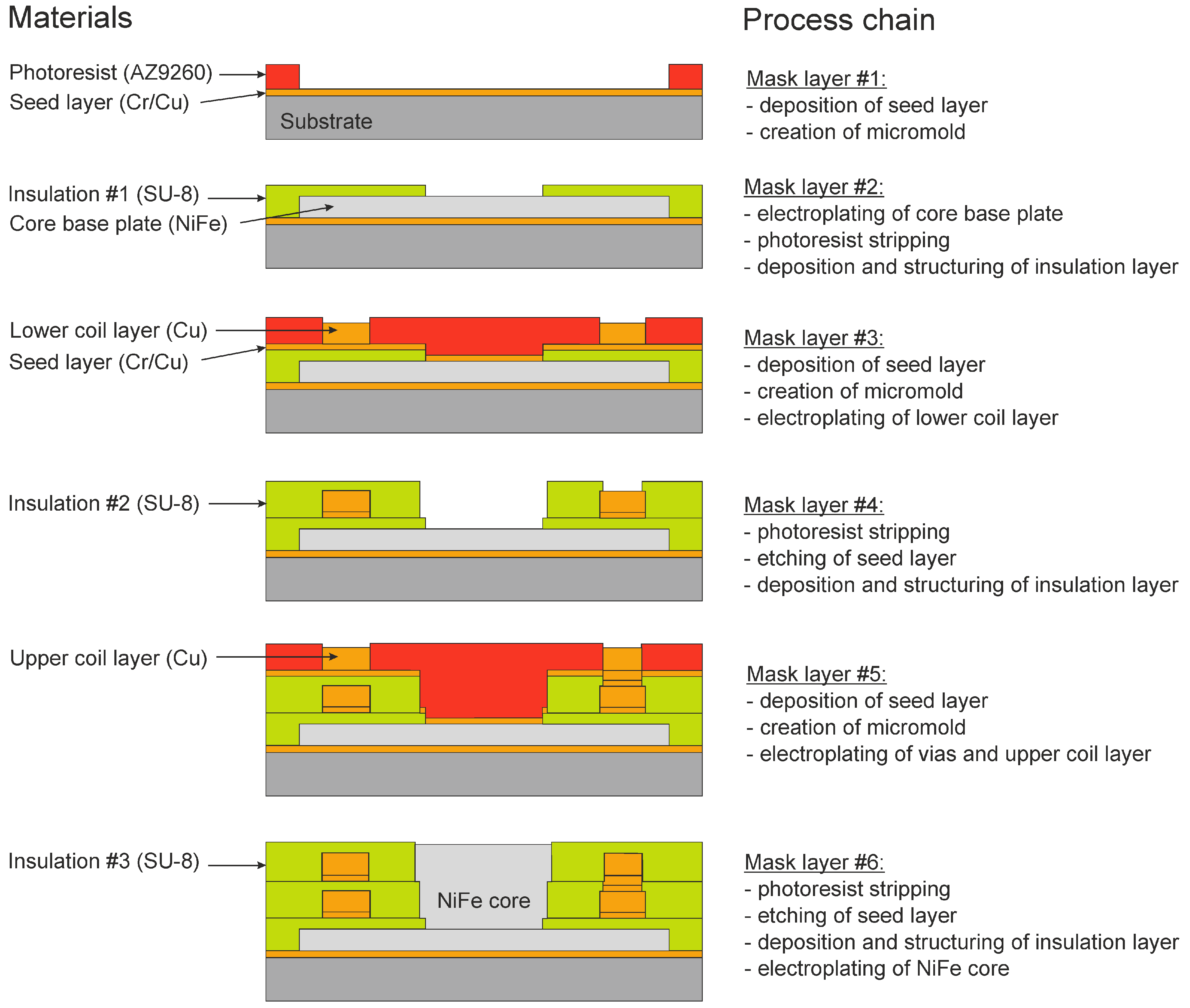
4. Designs of Electromagnetic Micromotors
4.1. Linear VR Stepper Motor
4.2. Rotatory VR Stepper Motor
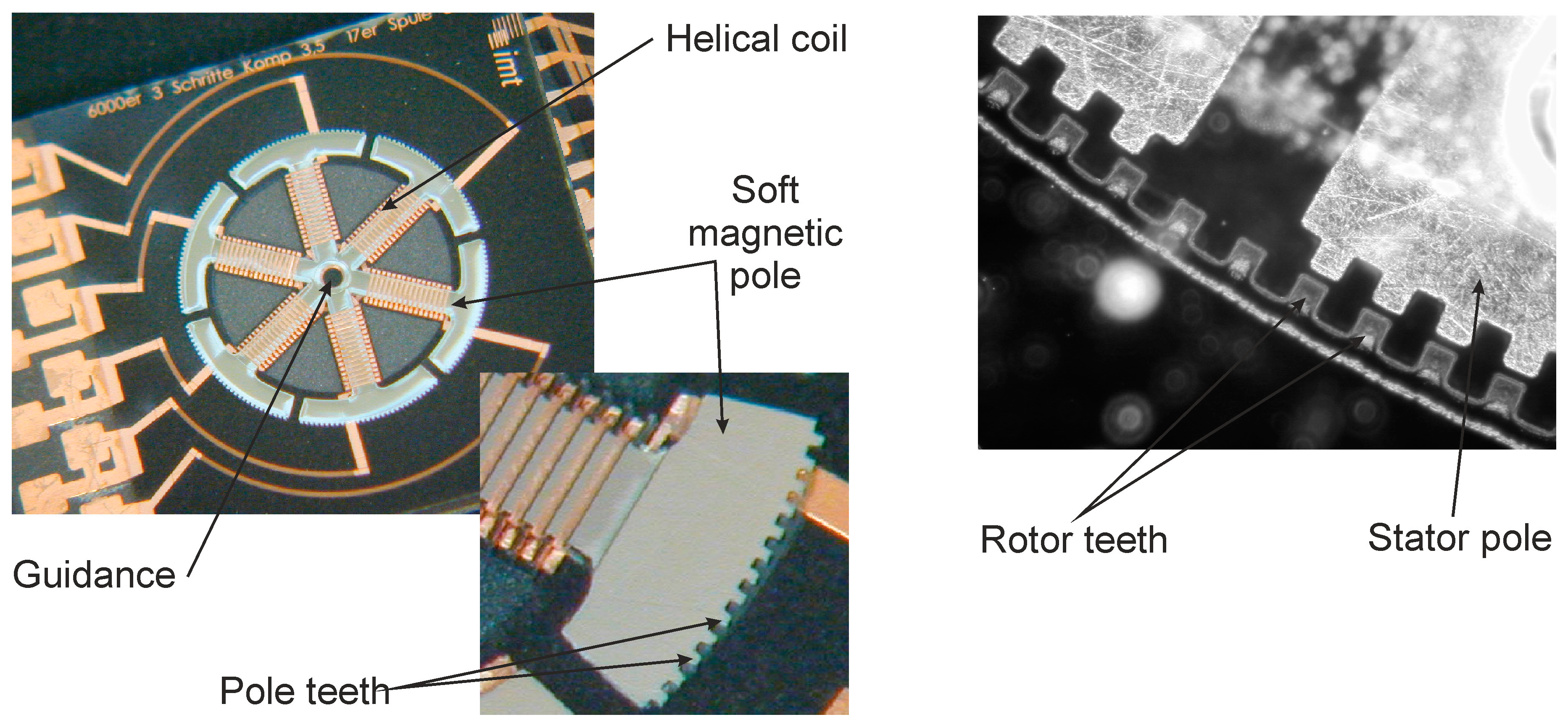
4.3. Rotatory Synchronous Micromotor
4.4. Linear Synchronous Micromotor
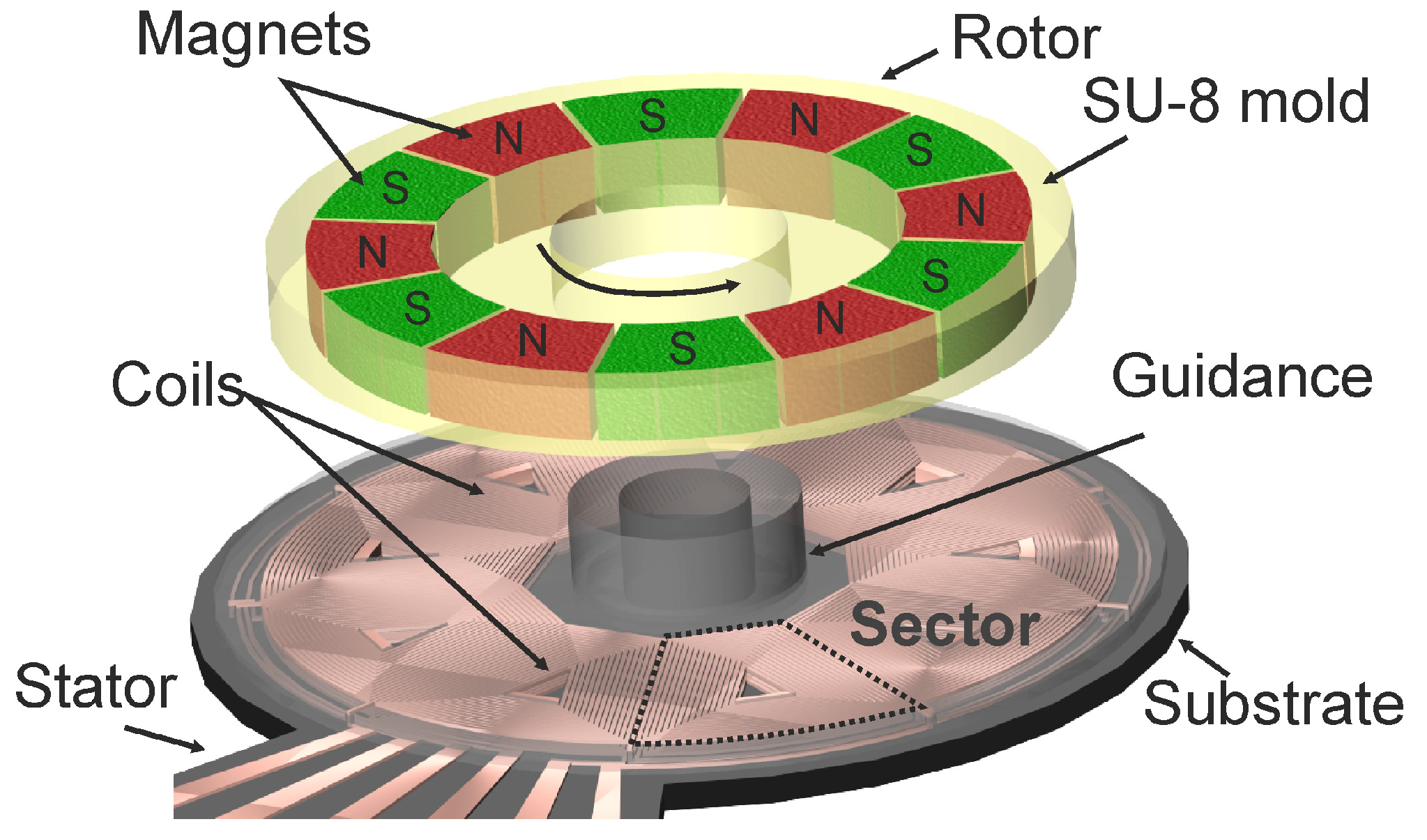
4.5. Plunger Coil and Linear Lorentz Force Microactuators

5. Applications

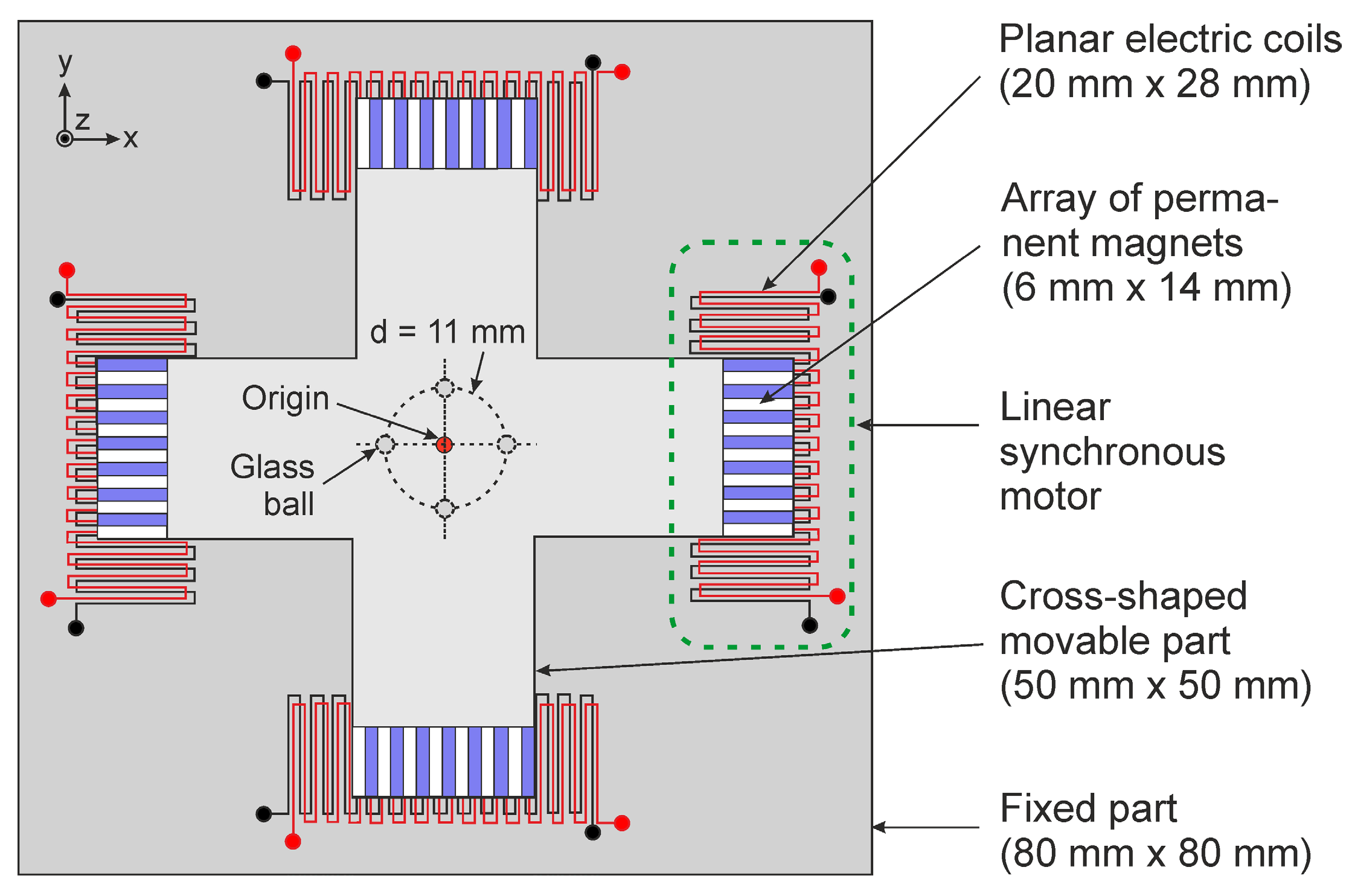
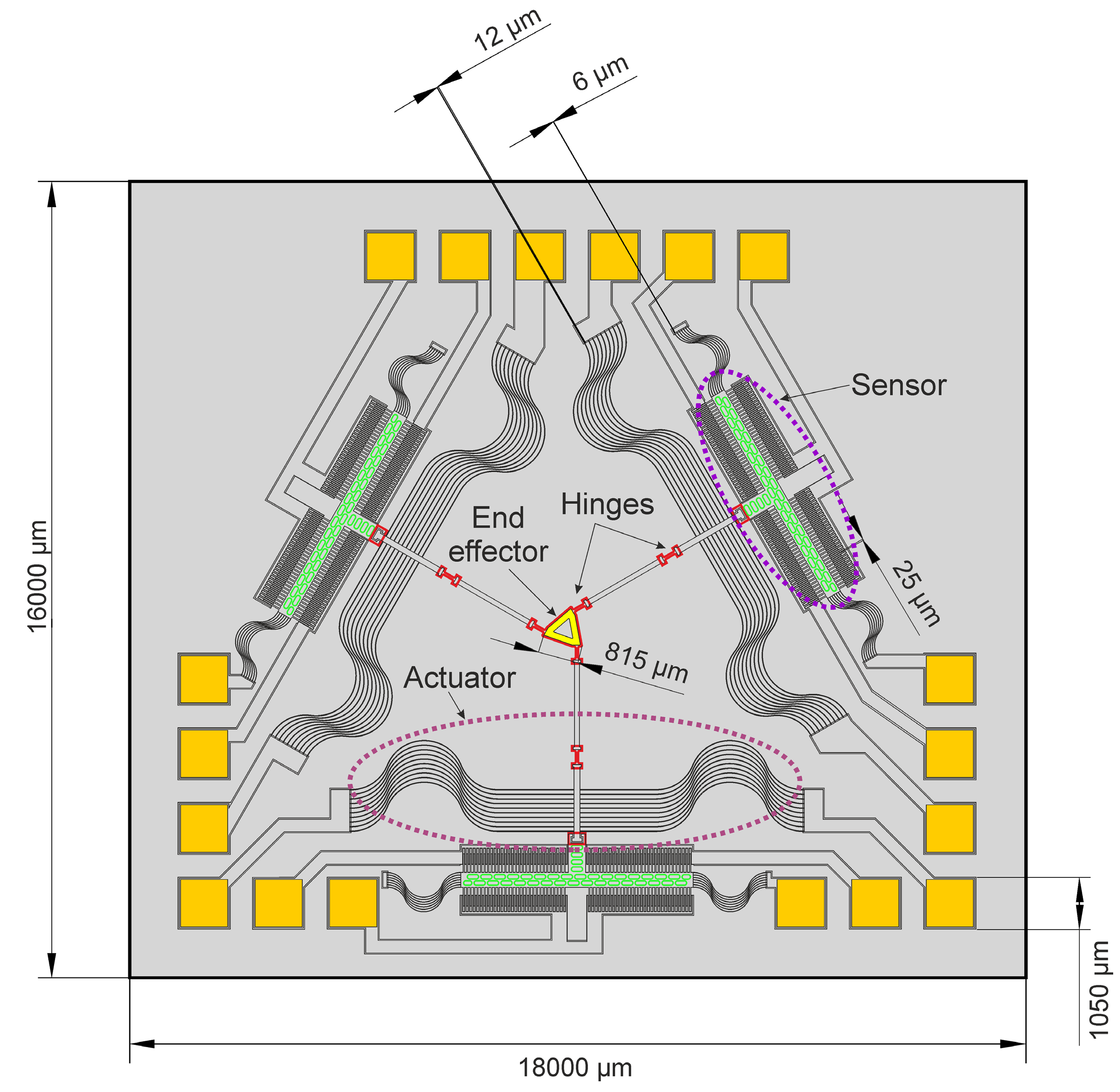
6. Conclusion and Outlook for the Future
Acknowledgments
Conflicts of Interest
References
- Fan, L.S.; Tai, Y.C.; Muller, R.S. IC-processed electrostatic micromotors. Sens. Actuators 1989, 20, 41–47. [Google Scholar] [CrossRef]
- Mehregany, M.; Nagarkar, P.; Senturia, S.D.; Lang, J.H. Operation of microfabricated harmonic and ordinary side-drive motors. In Proceedings of the IEEE Workshop on Micro Electro Mechanical Systems, Nappa Valley, CA, USA, 11–14 February 1990; pp. 1–8.
- Bart, S.F.; Lober, T.A.; Howe, R.T.; Lang, J.H.; Schlecht, M.F. Design considerations for micromachined electric actuators. Sens. Actuators 1988, 14, 269–292. [Google Scholar]
- Trimmer, W.S.N.; Gabriel, K.J. Design considerations for a practical electrostatic micro-motor. Sens. Actuators 1987, 11, 189–206. [Google Scholar] [CrossRef]
- Busch-Vishniac, I.J. The case for magnetically driven microactuators. Sens. Actuators A 1992, 33, 207–220. [Google Scholar] [CrossRef]
- Cugat, O.; Reyne, G.; Delamare, J.; Rostaing, H. Novel magnetic micro-actuators and systems (MAGMAS) using permanent magnets. Sens. Actuators A 2006, 129, 265–269. [Google Scholar] [CrossRef]
- Judy, J.W. Microelectromechanical systems (MEMS): Fabrication, design and applications. Smart Mater. Struct. 2001, 10, 1115–1134. [Google Scholar] [CrossRef]
- Becker, E.W.; Ehrfeld, W.; Hagmann, P.; Maner, A.; Münchmeyer, D. Fabrication of microstructures with high aspect ratios and great structural heights by synchrotron radiation lithography, galvanoforming and plastic moulding (LIGA process). Microelectron. Eng. 1986, 4, 35–56. [Google Scholar] [CrossRef]
- Guckel, H.; Skrobis, K.J.; Christenson, T.R.; Klein, J.; Han, S.; Choi, B.; Lovell, E.G.; Chapman, T.W. Fabrication and testing of the planar magnetic micromotor. J. Micromech. Microeng. 1991, 1, 135–138. [Google Scholar] [CrossRef]
- Guckel, H.; Christenson, T.R.; Skrobis, K.J.; Jung, T.S.; Klein, J.; Hartojo, K.V.; Widjaja, I. A first functional current excited planar rotational magnetic micromotor. In Proceedings of the IEEE Workshop on Micro Electro Mechanical Systems, Fort Lauderdale, FL, USA, 7–10 February 1993; pp. 7–11.
- Wagner, B.; Kreutzer, M.; Benecke, W. Linear and rotational magnetic micromotors fabricated using silicon technology. In Proceedings of the IEEE Workshop on Micro Electro Mechanical Systems, Travemünde, Germany, 4–7 February 1992; pp. 183–189.
- Ahn, C.H.; Kim, Y.J.; Allen, M.G. A planar variable reluctance magnetic micromotor with fully integrated stator and coils. J. Microelectromech. Syst. 1993, 2, 165–173. [Google Scholar] [CrossRef]
- Cho, H.J.; Ahn, C.H. Magnetically-driven bi-directional optical microscanner. J. Micromech. Microeng. 2003, 13, 383–389. [Google Scholar] [CrossRef]
- Taylor, W.P.; Brand, O.; Allen, M.G. Fully integrated magnetically actuated micromachined relays. J. Microelectromech. Syst. 1998, 7, 181–191. [Google Scholar] [CrossRef]
- Zahn, M. Derivation of the Korteweg-Helmholtz electric and magnetic force densities including electrostriction and magnetostriction from quasistatic Poynting’s theorem. In Proceedings of the IEEE Conference on Electrical Insulation and Dielectric Phenomena, Kansas City, MO, USA, 15–18 October 2006; pp. 186–189.
- Compter, J.C. Electro-dynamic planar motor. Precis. Eng. 2004, 28, 171–180. [Google Scholar]
- Gatzen, H.H.; Stölting, H.D.; Büttgenbach, S.; Dimigen, H. Novel variable reluctance micromotor for linear actuation. In Proceedings of Actuator 2000, Bremen, Germany, 19–21 June 2000; Volume 2, pp. 363–366.
- Kohlmeier, T.; Seidemann, V.; Büttgenbach, S.; Gatzen, H.H. An investigation on technologies to fabricate microcoilsfor miniaturized actuator systems. Microsyst. Technol. 2004, 10, 175–181. [Google Scholar] [CrossRef]
- Feldmann, M. Technologien und Applikationen der UV-Tiefenlithographie: Mikroaktorik, Mikrosensorik und Mikrofluidik; Shaker Verlag: Aachen, Germany, 2007. (In German) [Google Scholar]
- Lorenz, H.; Despont, M.; Fahrni, N.; Brugger, J.; Vettiger, P.; Renaud, P. High-aspect-ratio, ultrathick, negative-tone near-UV photoresist and its applications for MEMS. Sens. Actuators A 1998, 64, 33–39. [Google Scholar] [CrossRef]
- Wagner, B.; Benecke, W. Microfabricated actuator with moving permanent magnet. In Proceedings of the IEEE Workshop on Micro Electro Mechanical Systems, Nara, Japan, 30 January–3 February 1991; pp. 27–32.
- Cho, H.J.; Ahn, C.H. A bidirectional magnetic microactuator using electroplated permanent magnet arrays. J. Microelectromech. Syst. 2002, 11, 78–84. [Google Scholar] [CrossRef]
- Lagorce, L.K.; Brand, O.; Allen, M.G. Magnetic microactuators based on polymer magnets. J. Microelectromech. Syst. 1999, 8, 2–9. [Google Scholar] [CrossRef]
- Feldmann, M.; Büttgenbach, S. Novel microrobots and micromotors using Lorentz force driven linear microactuators based on polymer magnets. IEEE Trans. Magn. 2007, 43, 3891–3895. [Google Scholar] [CrossRef]
- Feldmann, M.; Büttgenbach, S. Linear variable reluctance (VR) micro motors with compensated attraction force: concept, simulation, fabrication and test. IEEE Trans. Magn. 2007, 43, 2567–2569. [Google Scholar] [CrossRef]
- Waldschik, A.; Feldmann, M.; Seidemann, V.; Büttgenbach, S. Development and fabrication of electromagnetic microactuators. In Design and Manufacturing of Active Microsystems; Büttgenbach, S., Burisch, A., Hesselbach, J., Eds.; Springer: Heidelberg, Germany, 2011; pp. 207–224. [Google Scholar]
- Hansen, S.; Gatzen, H.H. Development and fabrication of linear and multi-axis microactuators. In Design and Manufacturing of Active Microsystems; Büttgenbach, S., Burisch, A., Hesselbach, J., Eds.; Springer: Heidelberg, Germany, 2011; pp. 225–244. [Google Scholar]
- Waldschik, A.; Feldmann, M.; Büttgenbach, S. Rotatory variable reluctance (VR) micro motors: Concept, simulation, fabrication and test. In Proceedings 11th International Conference on New Actuators, Bremen, Germany, 9–11 June 2008; pp. 453–456.
- Gehrking, R.; Demmig, S.; Ponick, B.; Feldmann, M.; Büttgenbach, S. A micro linear motor with integrated passive magnetic guidance. In Proceedings 32nd Annual Conference of the IEEE Industrial Electronics Society, Paris, France, 6–10 November 2006; pp. 1245–1250.
- Waldschik, A.; Feldmann, M.; Büttgenbach, S. Novel synchronous linear and rotatory micro motors based on polymer magnets with organic and inorganic insulation layers. Sens. Transducers J. 2008, 3, pp. 3–13. Available online http://www.sensorsportal.com/HTML/DIGEST/P_SI_51.htm (accessed on 22 October 2014).
- Waldschik, A. Elektromagnetische Mikroaktoren—Konzepte, Herstellung, Charakterisierung und Anwendungen; Shaker Verlag: Aachen, Germany, 2010. (In German) [Google Scholar]
- Feldmann, M.; Büttgenbach, S. Novel versatile electro magnetic micro actuators with integrated polymer magnets: Concept, fabrication and test. In Proceedings 10th International Conference on New Actuators, Bremen, Germany, 14–16 June 2006; pp. 709–712.
- Waldschik, A.; Büttgenbach, S. Micro gear pump with internal electromagnetic drive. Microsyst. Technol. 2010, 16, 1581–1587. [Google Scholar] [CrossRef]
- Al-Halhouli, A.T. Recent advances in on-disk viscous micropumps. J. Microelectron. Electron. Packag. 2009, 6, 240–249. [Google Scholar]
- Al-Halhouli, A.; Demming, S.; Waldschik, A.; Büttgenbach, S. Implementation of synchronous micromotor in developing integrated microfluidic systems. Micromachines 2014, 5, 442–456. [Google Scholar] [CrossRef]
- Al-Halhouli, A.T.; Kilani, M.I.; Waldschik, A.; Phataralaoha, A.; Büttgenbach, S. Development and testing of a synchronous micropump based on electroplated coils and microfabricated polymer magnets. J. Micromech. Microeng. 2012, 22. [Google Scholar] [CrossRef]
- Kilani, M.I.; Al-Halhouli, A.T.; Büttgenbach, S. Shear stress analysis in a ferrolfuidic magnetic micropump. Nanoscale Microscale Thermophys. Eng. 2011, 15, 1–15. [Google Scholar] [CrossRef]
- Feldmann, M.; Demming, S.; Lesche, C.; Büttgenbach, S. Novel electro magnetic micro pump. Proc. SPIE 2007, 6799. [Google Scholar] [CrossRef]
- Khan, M.U.; Bencheikh, N.; Prelle, C.; Lamarque, F.; Beutel, T.; Büttgenbach, S. A long stroke electromagnetic xy positioning stage for micro applications. Trans. Mechatron. 2012, 17, 866–875. [Google Scholar] [CrossRef]
- Büttgenbach, S.; Feldmann, M. Electromagnetic parallel microrobot for micro- and nano-handling. In Proceedings 17th IFAC World Congress, Seoul, Korea, 6–11 July 2008; pp. 12757–12762.
- Tang, X.; Zhang, D.; Li, Z.; Chen, J. An omni-directional wall-climbing microrobot with magnetic wheels directly integrated with electromagnetic micromotors. Int. J. Adv. Robot. Syst. 2012, 9. [Google Scholar] [CrossRef]
- Boese, C.; Feldmann, M.; Büttgenbach, S. Closed-loop control for a parallel microrobot based on integrated capacitive position sensors. In Proceedings 10th International Symposium Measurement and Quality Control, Osaka, Japan, 5–9 September 2010; pp. F5-022:1–F5-022:4.
© 2014 by the authors; licensee MDPI, Basel, Switzerland. This article is an open access article distributed under the terms and conditions of the Creative Commons Attribution license (http://creativecommons.org/licenses/by/4.0/).
Share and Cite
Büttgenbach, S. Electromagnetic Micromotors—Design, Fabrication and Applications. Micromachines 2014, 5, 929-942. https://doi.org/10.3390/mi5040929
Büttgenbach S. Electromagnetic Micromotors—Design, Fabrication and Applications. Micromachines. 2014; 5(4):929-942. https://doi.org/10.3390/mi5040929
Chicago/Turabian StyleBüttgenbach, Stephanus. 2014. "Electromagnetic Micromotors—Design, Fabrication and Applications" Micromachines 5, no. 4: 929-942. https://doi.org/10.3390/mi5040929



